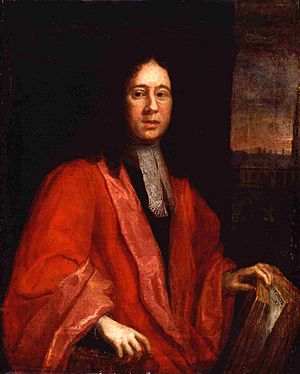John Stearne (physician) facts for kids
John Stearne (1624–1669) was an important Irish scholar and doctor. He is famous for starting the Irish College of Physicians, a special group for doctors in Ireland.
Contents
Early Life and Studies
John Stearne was born on November 26, 1624, in Ardbraccan, Ireland. This was the home of his great-uncle, James Ussher, who was a bishop. John's father, also named John Stearne, had moved to Ireland from Cambridge.
When he was 15, in 1639, John Stearne started studying at Trinity College, Dublin. He earned a scholarship in 1641. During a time of conflict called the Irish Rebellion of 1641, Stearne moved to England. In 1643, he went to Cambridge University. There, he studied medicine at Sidney Sussex College. He spent about seven years in Cambridge and then some time in Oxford.
Stearne had been chosen as a fellow (a senior member) at Trinity College, Dublin, in 1643. But a government group called the Rump Parliament removed him from this position. When he returned to Ireland in 1651, he got his fellowship back. This was thanks to Henry Cromwell, a powerful leader at the time.
Life and Work in Dublin
In 1656, John Stearne became the first teacher of Hebrew at Trinity College, Dublin. He earned his medical degree (M.D.) in 1658 and a law degree (LL.D.) in 1660. He left his fellowship in 1659. But after the king returned to power in 1660, Stearne was given a senior fellowship again. He was also allowed to marry, which was unusual for fellows at that time. In the same year, he became a professor of law.
While holding these university jobs, Stearne also worked as a doctor in Dublin. He even got special permission to live outside the college walls.
Founding the College of Physicians
Stearne is best known for creating the Irish College of Physicians. In 1660, he suggested that Trinity Hall, a building linked to the university, should become a college for doctors. This idea was approved. Stearne became the first president of this new college. Only students from Trinity College could join.
In 1662, Stearne was made a professor of medicine at the university for life. In 1667, the College of Physicians received an official charter. This charter created a governing group of fourteen fellows, including famous people like Sir William Petty. John Stearne was chosen to lead them as president for life.
Death
John Stearne died in Dublin on November 18, 1669. He was 44 years old. He asked to be buried in the chapel of Trinity College. His friend, Henry Dodwell the elder, wrote his epitaph. It described Stearne as a great philosopher, doctor, and theologian (a person who studies religion).
His Writings
John Stearne wrote several books. They were all published in Dublin:
- Animi Medela (1653)
- Thanatologia (1656)
- Adriani Heerboordii disputationum de concursu examen (1660)
- De Electione et Reprobatione (1662)
- Aphorismi de Felicitate (1664)
- De Destinatione (1672) - This book was published after his death by his student, Henry Dodwell.
Family Life
In 1659, John Stearne married Dorothy Ryves. She was the daughter of Charles Ryves and the sister of Sir Richard Ryves. John and Dorothy had three daughters and one son. Their son, John Sterne, later became a bishop.


